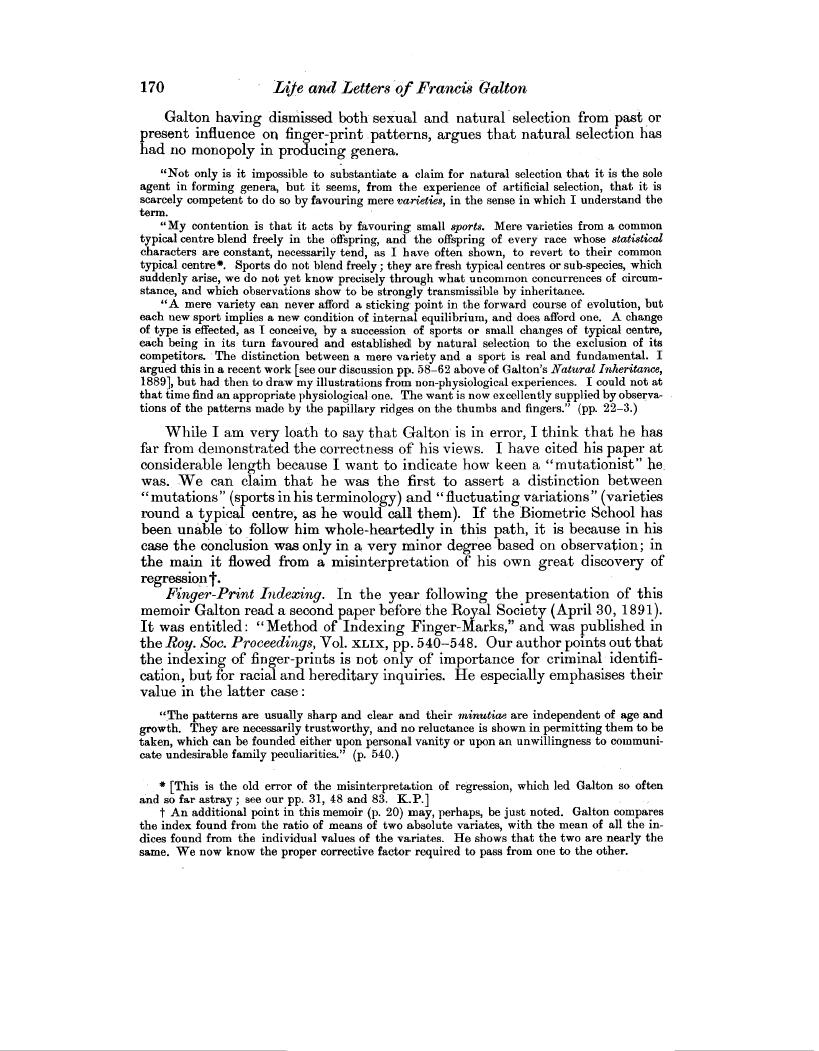| ||||||

OCR Rendition - approximate
170 Life and Letters of Francis Galton Galton having dismissed both sexual and natural selection from past or present influence or% finger-print .patterns, argues that natural selection has had no monopoly in producing genera. "Not only is it impossible to substantiate a claim for natural selection that it is the sole agent in forming genera, but it seems, from the experience of artificial selection, that it is scarcely competent to do so by favouring mere varieties, in the sense in which I understand the term. "My contention is that it acts by favouring small sports. Mere varieties from a common typical centre blend freely in the offspring, and the offspring of every race whose statistical characters are constant, necessarily tend, as I have often shown, to revert to their common typical centre*. Sports do not blend freely; they are fresh typical centres or sub-species, which suddenly arise, we do not yet know precisely through what uncommon concurrences of circumstance, and which observations show to be strongly transmissible by inheritance. "A mere variety can never afford a sticking point in the forward course of evolution, but each new sport implies a new condition of internal equilibrium, and does afford one. A change of type is effected, as I conceive, by a succession of sports or small changes of typical centre, each being in its turn favoured and established by natural selection to the exclusion of its competitors. The distinction between a mere variety and a sport is real and fundamental. I argued this in a recent work [see our discussion pp. 58-62 above of Galton's Natural Inheritance, 1889], but had then to draw my illustrations from non-physiological experiences. I could not at that time find an appropriate physiological one. The want is now excellently supplied by observations of the patterns made by the papillary ridges on the thumbs and fingers." (pp. 22-3.) While I am very loath to say that Galton is in error, I think that he has far from demonstrated the correctness of his views. I have cited his paper at considerable length because I want to indicate how keen a "mutationist" he. was. We can claim that he was the first to assert a distinction between "mutations" (sports in his terminology) and "fluctuating variations" (varieties round a typical centre, as he would call them). If the Biometric School has been unable to follow him whole-heartedly in this path, it is because in his case the conclusion was only in a very minor degree based on observation; in the main it flowed from a misinterpretation of his own great discovery of regression t. Finger-Print Indexing. In the year following the presentation of this memoir Galton read a second paper before the Royal Society (April 30, 1891). It was entitled: "Method of Indexing Finger-Marks," and was published in the Roy. Soc. Proceedings, Vol. XLIX, pp. 540-548. Our author points out that the indexing of finger-prints is not only of importance for criminal identification, but for racial and hereditary inquiries. He especially emphasises their value in the latter case "The patterns are usually sharp and clear and their minutiae are independent of age and growth. They are necessarily trustworthy, and no reluctance is shown in permitting them to be taken, which can be founded either upon personal vanity or upon an unwillingness to communicate undesirable family peculiarities." (p. 540.) * [This is the old error of the misinterpretation of regression, which led Galton so often and so far astray; see our pp. 31, 48 and 83. K.P.] t An additional point in this memoir (p. 20) may, perhaps, be just noted. Galton compares the index found from the ratio of means of two absolute variates, with the mean of all the indices found from the individual values of the variates. He shows that the two are nearly the same. We now know the proper corrective factor required to pass from one to the other.
|